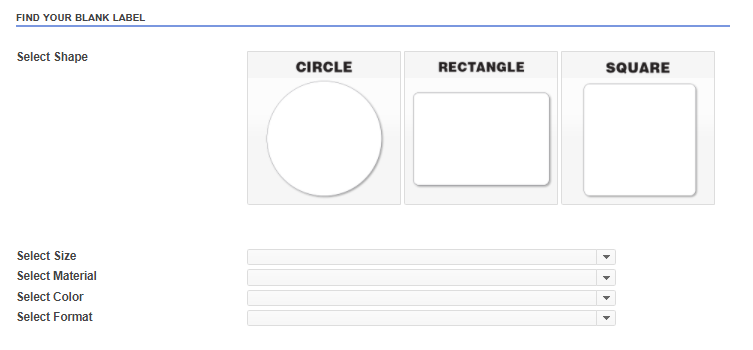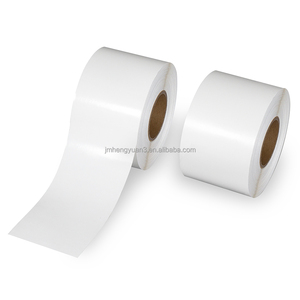Recognizing Just How Blank Labels Work to Improve Your Labeling Experience
Comprehending the mechanics of blank labels is important for maximizing your labeling techniques throughout different contexts. To completely grasp how these labels can transform your processes, one have to think about the various types offered and the myriad means they can be tailored to fit particular demands.

Benefits of Making Use Of Blank Labels
Blank labels offer a flexible option for various labeling needs, making them indispensable in both personal and professional setups. Their versatility enables individuals to create personalized labels customized to particular needs, boosting business effectiveness. Whether used in home workplaces, retail environments, or commercial applications, blank labels assist in the recognition and classification of items, papers, and individual products.
One considerable advantage of blank labels is their cost-effectiveness. By allowing users to publish just the labels they need, waste is minimized, and stock monitoring becomes much more convenient. In addition, blank labels work with various printing techniques, including inkjet and printer, making them obtainable for various customers.

Additionally, the use of blank labels streamlines the procedure of updating details, as users can quickly publish new labels to replace obsolete ones, ensuring that all items and records are precisely classified. Overall, blank labels give a useful and effective labeling remedy for diverse applications.
Kinds Of Blank Labels Available
What alternatives are available when it comes to blank labels? Blank labels come in a variety of types, each suited for different applications and preferences.
One more prominent choice is artificial labels, usually made from products like polyester or plastic. These labels are recognized for their resilience and resistance to water, chemicals, and tearing, making them appropriate for extreme atmospheres. They are frequently utilized in commercial settings or for labeling products that may be subjected to moisture.
Furthermore, there are thermal transfer labels, which need a printer that makes use of heat to transfer ink onto the label surface. These labels are favored for their premium print and durability.
Last but not least, specialized labels accommodate specific needs, such as removable labels for temporary use or high-temperature labels for extreme problems. Recognizing these choices enables customers to select the most suitable blank tag for their one-of-a-kind labeling needs.
Modification Options for Labels
A broad variety of personalization alternatives is readily available for labels, allowing users to tailor them to particular needs and branding requirements. Users can select from numerous dimensions, forms, and products to make certain that the labels properly fit their designated function. Common materials include paper, polyester, and vinyl, each providing various levels of toughness and visual appeal.
Shade alternatives play an essential duty in modification, making it possible for brands to maintain uniformity with their company identity. Individuals can select from a spectrum of colors or also go with personalized printing to match specific branding components. In addition, labels can be published with unique styles, logos, and text, enhancing brand name acknowledgment and visual effect.
One more important facet is the choice of adhesive. Tags can be created with permanent, detachable, or repositionable adhesives, depending upon the application requirements. This adaptability allows for reliable labeling services throughout various environments, from retail to commercial setups.

Tips for Effective Labeling
Effective labeling exceeds modification; it also entails critical factors to consider that boost capability and interaction. To attain reliable labeling, start by plainly specifying the function of each label. Consider the details that requires to be conveyed and guarantee it exists in a simple way. Using succinct language and preventing lingo can dramatically boost comprehension.
Next, focus on exposure by selecting ideal shades and fonts. High comparison between text and history improves readability, while larger fonts promote quick recognition. Additionally, make sure that find out here now labels are positioned in a constant and sensible manner, making it less complicated for users to find and analyze information.
Take into consideration the toughness of labels as well. Pick materials fit for the specific atmosphere where the labels will certainly be utilized, whether it be inside or outdoors. Waterproof linked here or tear-resistant choices may be needed depending on the context.
Finally, consistently evaluation and upgrade your labels to reflect any kind of modifications in information or usage. This aggressive method not just preserves clarity but likewise stays clear of complication over time. By following these ideas, you can take full advantage of the effectiveness of your labeling initiatives, ensuring they offer their intended objective efficiently.
Applications of Blank Labels
Blank labels supply various applications throughout numerous industries, making them a very useful tool for company and communication. These versatile labels are typically utilized in stockrooms for stock monitoring, permitting businesses to easily identify and track products. By using blank labels to storage space containers, racks, or pallets, companies can streamline their operations and reduce the likelihood of errors.
In the healthcare industry, blank labels play an essential duty in classifying drugs and clinical products, making certain proper recognition and use. Customizable labels can visit this page consist of crucial details such as dose, expiry dates, and individual information, improving safety and compliance.
In retail, blank labels assist in prices products, offering promotions, or labeling shelf areas, which eventually enhances the customer experience. They permit fast updates to pricing or item details without the requirement for pre-printed labels.
Additionally, blank labels are useful for personal use, such as arranging office, crafting, or labeling food containers. Their adaptability permits individuals to create customized options that satisfy particular needs. Overall, the applications of blank labels are considerable, emphasizing their value in promoting efficiency and quality in various setups.
Conclusion
In conclusion, blank labels present a flexible and reliable solution for various identifying requirements. Eventually, the assimilation of blank labels right into functional processes contributes to enhanced effectiveness, making them an invaluable resource for both personal and expert usage.